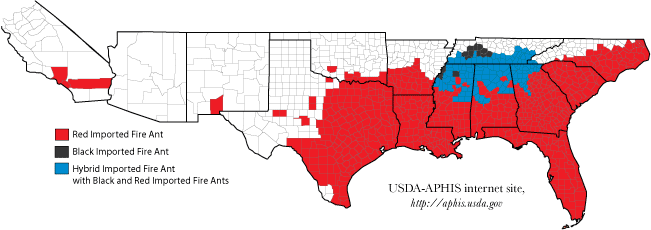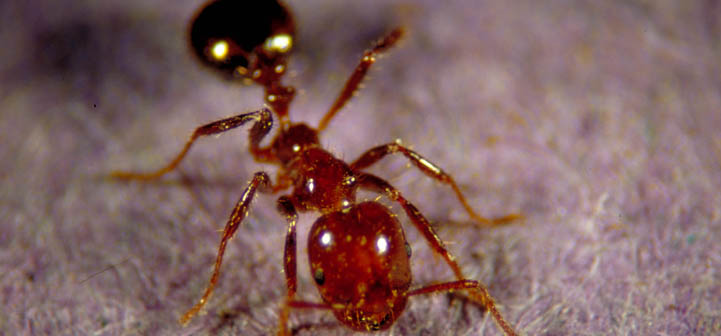History of Control Efforts

More than 75 years ago, the red imported fire ant, Solenopsis invicta Buren, was accidentally brought into Mobile, Alabama, from South America. It now infests more than 325 million acres, comprising most of eleven southern states and Puerto Rico, with infestations also in New Mexico and California. It has recently been reported in northern Mexico, Australia, Taiwan and China. Another species, the black imported fire ant, Solenopsis richteri Forel, was introduced earlier, but this species is limited to northeastern Mississippi, northwestern Alabama, and
Tennessee. Colonies move vertically and horizontally in the soil profile to escape floods, droughts, and extreme temperatures. When new colonies are not actively foraging, they may be unaffected by baits or other pesticides applied to the soil surface.
Technological obstacles to eradication

Pesticide treatments are expensive, time-consuming, and limited in their effectiveness. There are three basic approaches:
- Surface treatment using a residual contact poison. This approach is the least environmentally sound because the treated surface remains toxic for a long time. The ants may survive by foraging underground.
- Individual mound treatment. This approach involves applying a large volume of pesticide to reach the queen. However, it is nearly impossible to locate all of the colonies in an area and difficult to manipulate large volumes of liquid. Also, mound treatment is more expensive and time-consuming than broadcast treatments. Colonies not eliminated may move or split into several colonies.
- Bait treatment. This approach uses some sort of attractive substance the ants like to eat. Unfortunately, baits are not always consumed, and the bait’s attractiveness is short-lived. The bait must be slow-acting and effective over a range of doses, since the dose the ants get cannot be controlled. Baits may also be attractive to and kill some native ant species that compete with fire ants.
Economic, regulatory, and environmental obstacles to eradication

The best way to treat large areas (hundreds of acres) is by an aerial application of bait. The larger the treatment area, the more slowly reinfestation occurs. However, not all areas can be treated because of label restrictions and application limitations. Even with a bait product, it is not feasible to treat the entire infested area or even a large part of a single state, and untreated areas may be reinfested. If periodic treatments are discontinued, the area may become more infested than it originally was within a year or two.
